You've likely heard the term agile project management. Nevertheless, you might have no clue what it actually is or how it's used in practice.
Never fear, we're here to explain exactly what agile project management is, why it's become so popular, and the kinds of benefits it can offer you and your project team.
The agile approach to project management is here to stay and it's much more than just a buzzword. Buckle up!
What is agile project management?

Agile project management is one of the most popular project management approaches out there. It takes an iterative approach because it breaks a project down into chunks, works on them over short periods of time called sprints, and then repeats the process until the project is complete and all the deliverables are finalized.
Agile project management is further characterized by visualizing progress and processes, frequent, open communication, customer collaboration, a high degree of flexibility and openness to change, and abundant feedback.
Agile project management was initially thought up as a solution for software development projects in 2001, but is now used successfully by a wide range of industries all around the world. It's largely based on the Agile Manifesto, which assigns 4 core values and 12 principles to the agile approach.
Agile frameworks are largely seen as being a reaction against traditional conceptions of project management.
Who uses agile project management?
One of the best things about agile project management is its flexibility. That means just about any team can use it. It doesn't matter what industry you work in, whether your team is big or small, or what kinds of resources you have access to. The agile approach can do wonders for you.
The agile project management approach was initially thought up with software development in mind. However, since then it's been expanded and agile methods are used successfully far and wide.
If your development team works on projects with any of the following characteristics, you will love agile project management:
- Projects with changing requirements, expectations, and parameters
- Projects that evolve throughout their lifecycle and don't stay consistent from beginning to end
- Projects that prioritize customer relationships and feedback
- Projects that can benefit from continuous self-improvement and optimization
- Projects that rely on consistent, reliable feedback (both internal and external)
- Projects that contain a large number of tasks that need to be worked on at the same time
The characteristics of agile project management

No two agile projects are exactly alike. There are many ways to implement agile project management methodologies while yielding totally different results. Nevertheless, there are a few central characteristics you can count on using if you want to work in a truly agile environment.
User stories
In agile project management, work requests are often stylized as user stories. This is because the agile method focuses on the customer perspective. These user stories outline what work a customer wants to get done and why. They don't need to be long, just long enough to provide all the essential information that agile teams need to estimate the work that has to be done.
Sprints
Sprint is just a fancy word for a period of time. Agile teams work in iterations of 1-4 weeks called sprints. Each sprint is based on a specific task or goal, so the idea is that you keep working in short iterations called sprints until you finish your project. Then, you start the process all over again.
Daily meetings
Communication is king when it comes to agile values. Short meetings should happen every day and team members should be in constant communication with each other. These meetings don't need to be long, but they should cover what people are currently working on and bring everyone up to speed.
Agile project management, what benefits?

Agile project management is popular for a good reason. More than just a project management trend, it presents project managers and their teams with a wide range of tried-and-tested benefits. With the incredible results it brings, we have no doubt that agile methodology is here to stay.
Take a look at some of agile project management's greatest benefits according to us, running our business across 4 continents at Slite:
1. Improved customer experience and satisfaction
Customer satisfaction is paramount to the success of any project development process. Happy customers means better sales, improved word of mouth, increased loyalty, and enriched customer relationships.
Because agile project management prioritizes customer collaboration and feedback as one of its four core values, it ultimately leads to improved customer experience and satisfaction.
Agile project management practices achieve this by making a close working relationship with both customers and stakeholders paramount. Agile project management teams make sure that they're developing something that addresses customers' paint points and solves problems that really need solving.
Agile project management also makes it easy to integrate customer feedback throughout the development process. Because testing, analyzing, and reviewing is woven into agile sprints, there are many opportunities to weave new findings into project versions.
2. Fewer risks, greater adaptability
One of the biggest reasons why more traditional project management approaches fail is because they are too rigid and linear. They depend on events unfolding in a certain way, and when they don't, it jeopardizes the entire project. This kind of process simply isn't sustainable in the current day as people work on dynamic, complicated projects full of variables and moving parts.
Agile project management methods are perfect for these kinds of projects because they allow for greater flexibility and take fewer risks. They allow project teams to make changes, account for new conditions, and optimize their work during their project's development, rather than only before work begins or after it concludes.
Because of agile project management's iterative approach, project teams can take advantage of shorter development cycles and continuous feedback and pivot their project strategy at any time. That fact combined with increased transparency and more frequent reporting makes for projects that are easier to manage and entail less risk.
3. Agile teams are happier teams
At the end of the day, no one likes being micromanaged. It's tiresome, annoying, and makes people feel like they aren't trusted to work autonomously by management. Fortunately, agile project management methodologies make for happier teams because they do the opposite of micromanaging.
Agile project management empowers all individual team members to play key roles in a project's success. They're entrusted to solve problems, brainstorm, come up with new ideas, make suggestions, and take on responsibility.
Since agile project management methods encourage a high degree of communication and collaboration, agile teams feel happier because they get to know each other better, build morale, and enjoy a positive rapport.
The Agile Manifesto
The Agile Manifesto was written in 2001 by a group of software engineers in Utah. Initially created to turn the project management status quo on its head, it now acts as the foundation of many modern project management methodologies.
Although the Agile Manifesto was initially written to guide software engineering and development, it's now applied to project management more generally.
The 4 core values of agile projects are one of the most important aspects of the Agile Manifesto.
The 4 core values of agile
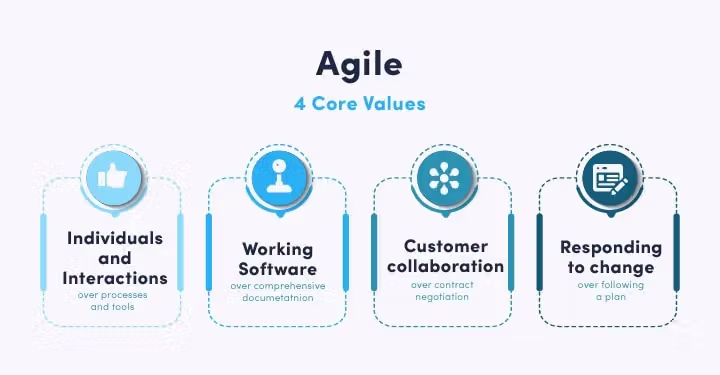
1. Individuals and interactions over processes and tools
Traditional project management often relies on formal processes and tools. Agile project management turns that notion upside down by shifting the focus onto individuals and interactions. The Agile Manifesto proposes that the people and communication behind projects need to be prioritized because they're responsible for project development, responsiveness, and meeting customers' needs.
2. Working software over comprehensive documentation
One of the biggest time-wasters in the project management world is documentation. Although it's necessary, there's a time and place for it. The Agile Manifesto deemphasizes comprehensive documentation processes and encourages teams to focus on the most important stuff instead... the results. Basically, spend less time writing documentation and concentrate on producing something that really works.
3. Customer collaboration over contract negotiation
Agile project management highlights the fact that there's a serious problem with the relationship between customers and traditional project management methods. In traditional project management, product requirements are usually defined at the beginning of a project. Unfortunately, they aren't looked at much after that and don't go through many changes.
Agile methodologies suggest collaborating with customers throughout the entire development process. That means that their feedback is collected and integrated throughout the different stages of a project's lifecycle. This leads to a better finished product that truly meets customers' needs as well as improved customer experience.
4. Responding to change over following a plan
Another issue with traditional project management is the fact that it relies heavily on a strict project plan. Under this framework, project teams make a plan for a project, carry out the steps of the plan, and finish their project... just like that.
In an ideal world, that sounds great. However, we all know that projects never actually happen that way. There are always changes to be made, roadblocks to account for, resources to source, logistics to optimize, and more.
...this is what makes the agile approach to project management so great. It's designed to respond to change, so it's much easier to carry out a successful, modern project from beginning to end (complete with unexpected elements).
The 12 principles of agile
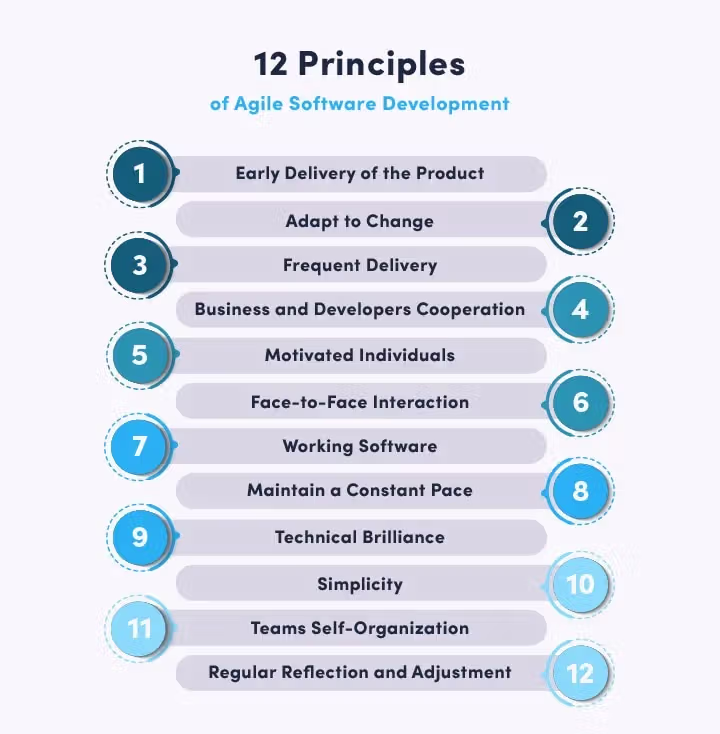
The Agile Manifesto's 4 core principles are further supported and expanded upon with its 12 project management principles. If you're not already familiar, they are as follows:
1. Satisfy your customer with the early and continuous delivery of valuable software (or whatever other product or service you're working on).
2. Welcome changing project requirements, even if you're in the later stages of project development. Agile processes harness change for the customer's competitive advantage.
3. Deliver projects frequently, anywhere between every couple of weeks or couple of months, with a preference for shorter timescales.
4. Agile team members have to work together daily when collaborating on a given project.
5. Build projects around motivated individuals. Give them the environment and support they need and trust them to get the job done.
6. Face to face conversation is the most efficient and effective method of conveying information to and within different teams.
7. The final product is the primary measure of progress.
8. Agile processes promote sustainable development. All stakeholders should be able to maintain a constant pace indefinitely.
9. Pay continuous attention to technical excellence. Good design enhances agility.
10. Simplicity, the art of maximizing the amount of work not done, is essential.
11. The best architectures, requirements, and designs emerge from self-organizing teams.
12. At regular intervals, the team reflects on how to become more effective, then tunes and adjusts its behaviour accordingly.
The 2 most popular agile methodologies
Naturally, there's no one way to approach agile project management. Some approaches are best for software, whereas others come from manufacturing. Essentially, there are different methodologies you can try out in order to determine what works best for your team.
Two of the biggest and most popular agile methodologies out there at the moment are scrum and kanban. We've broken them down for you below.
Scrum
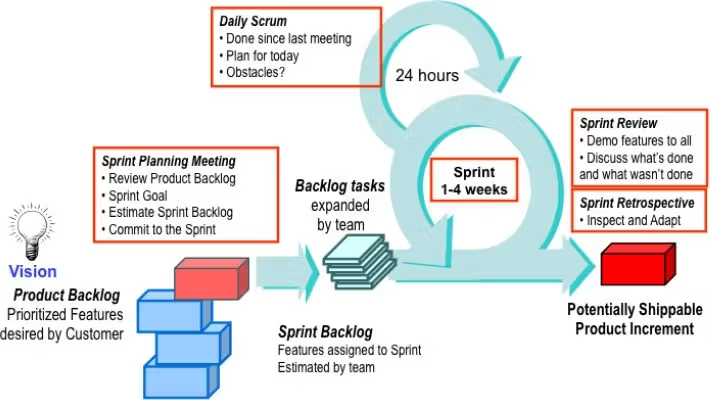
The scrum framework is one of the most popular agile approaches out there. In fact, many people make the mistake of thinking that scrum and agile are the exact same thing. While they are different, scrum is certainly a well-known agile methodology and is closely related to everything it stands for.
While the scrum framework doesn't tell project teams exactly how to do things, they provide a framework within which agile teams should plan, carry out, and get their projects done.
There are only 3 project management roles within the scrum framework: scrum master, product owner, and team.
Generally speaking, the scrum framework can be broken down as follows:
1. Start with a clear project vision and an established set of product features in order of importance (referred to here as the product backlog).
Note: The product owner is responsible for the product backlog.
2. Kick things off with a sprint planning meeting. A "sprint" refers to the period of time in which your product team accomplishes a specific task. The length of "sprints" usually stays the same once decided upon but varies between 1-4 weeks. Sprint planning meetings entail:
- Reviewing the product backlog
- Establishing your sprint goal
- Estimating your sprint backlog
- Committing to the upcoming sprint
3. Sprint backlogs refer to the tasks that project teams assign to a specific sprint. After your sprint planning meeting, work on them begins.
4. Check in with each other for 15 minutes daily in a meeting known as a "scrum." Keep it short and sweet, but make sure that scrum team members identify what they've worked on since the last meeting, their plan for the day, and what obstacles (if any) they're facing.
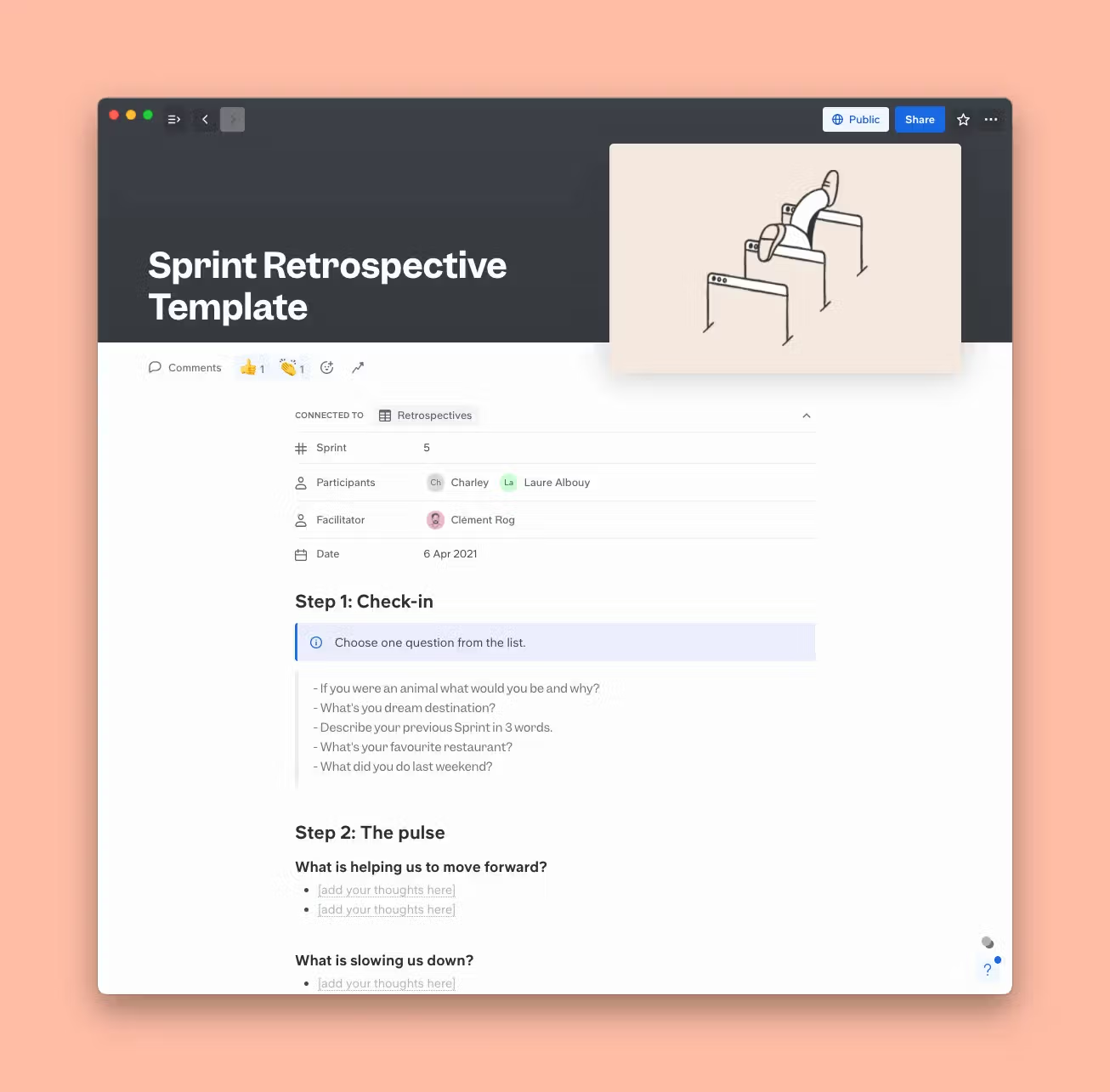
5. Once your sprint has concluded after 1-4 weeks, hold a sprint review meeting. In this meeting, you should present your finished project to your team and discuss what was accomplished (and what still needs to be worked on).
6. It's also important to hold a sprint retrospective meeting. This can be done as part of your sprint review meeting or separately. Whatever the case, this meeting should focus on what improvements need to be made for the next sprint.
Note: Even better, if you need a template for your sprint retrospective meeting, we've got one you can use for free at Slite.
This meeting is essential because it drives home the 3 central pillars of scrum: team transparency, inspection, and adaptation.
Kanban
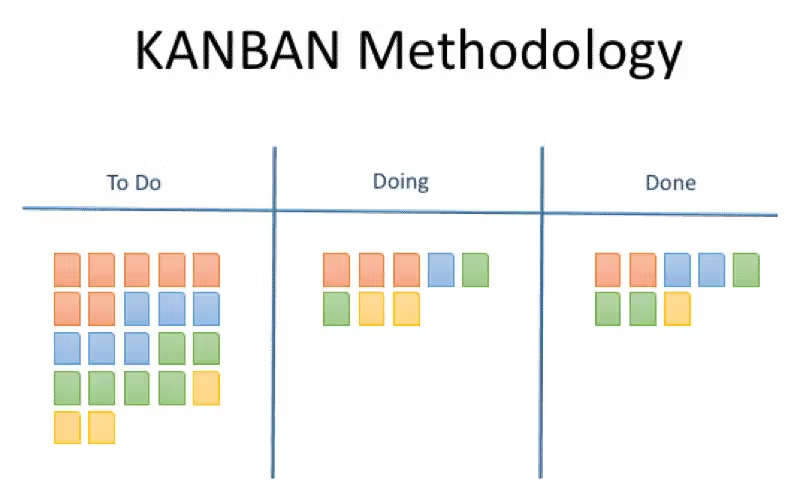
Kanban is another popular agile project management methodology. It differs from the scrum methodology because it doesn't focus on time-based iterations, but rather, it helps with visualization and workflow management throughout a project's lifecycle.
Kanban is a Japanese word that means "visual board" or "sign board." Although the term kanban method was coined in 2007, the system itself was initially used by Toyota in order to limit their work in progress in the 1960s.
Kanban boards can be organized in various ways, but the most simple approach is with 3 columns:
- To do
- Doing
- Done
Basically, you can visualize your project work by moving tasks through the 3 columns. It allows team members to identify bottlenecks and roadblocks in their workflows, visualize their progress, and keep tabs on everything that needs to get done.
You're ready to work on agile projects

As you can see, agile practices are much more than passing project management trends or buzzwords. They come together and create a framework that's truly effective in helping project management teams work together to their full potential and get things done.
If you're ready to start integrating agile approaches into your project management strategy, look no further. Keep this guide handy and refer to it whenever you need a little help.
Need guidance taking the first few steps? Read through the 4 core values and 12 principles of agile again and then do the following with your team:
- Hold a meeting, brainstorm, and get everyone to buy into the agile approach
- Consider taking some courses or hiring a guest speaker to teach you and your team about agile project management
- Make a list of pending projects coming down the pipe
- Organize your projects by order of importance and decide which one will be the subject of your first agile sprint
- Prepare to begin work on your first agile sprint!
Now, get to work! We can't wait to see what you come up with.

